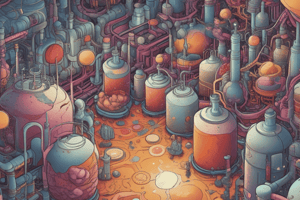Podcast
Questions and Answers
What are primary metabolites?
What are primary metabolites?
- Secondary metabolites of fermentation
- Produced during the growth phase (correct)
- Byproducts of anaerobic fermentation
- Produced during the stationary phase
Which of the following is a characteristic of anaerobic fermentation?
Which of the following is a characteristic of anaerobic fermentation?
- Utilizes oxygen for the metabolic process
- Involves the presence of light
- Produces only solid waste
- Converts sugars without the use of oxygen (correct)
Which microorganism is commonly used in the production of antibiotics?
Which microorganism is commonly used in the production of antibiotics?
- Bacillus subtilis
- Saccharomyces cerevisiae
- Aspergillus spp. (correct)
- Escherichia coli
What is the main advantage of continuous culture over batch culture?
What is the main advantage of continuous culture over batch culture?
Which application of industrial microbiology is related to environmental management?
Which application of industrial microbiology is related to environmental management?
What is a major challenge faced in industrial microbiology?
What is a major challenge faced in industrial microbiology?
What process is utilized for the production of fermented beverages?
What process is utilized for the production of fermented beverages?
What is a benefit of synthetic biology in industrial microbiology?
What is a benefit of synthetic biology in industrial microbiology?
Study Notes
Overview of Industrial Microbiology
- Definition: Application of microorganisms in industrial processes to produce products or perform functions.
- Importance: Essential for biotechnology, pharmaceuticals, food production, and environmental management.
Key Concepts
-
Microbial Products:
- Primary Metabolites: Produced during the growth phase (e.g., amino acids, ethanol).
- Secondary Metabolites: Produced during stationary phase (e.g., antibiotics, alkaloids).
-
Fermentation:
- Definition: Metabolic process converting sugars to acids, gases, or alcohol using microorganisms.
- Types:
- Aerobic fermentation (with oxygen)
- Anaerobic fermentation (without oxygen)
-
Microbial Strains:
- Strain Selection: Choosing the appropriate microorganism for product efficiency and yield.
- Common organisms:
- Bacteria: Escherichia coli, Bacillus subtilis
- Yeasts: Saccharomyces cerevisiae
- Fungi: Aspergillus spp.
Applications
-
Food Industry:
- Production of yogurt, cheese, and fermented beverages.
- Preservation through fermentation and microbial activity.
-
Pharmaceuticals:
- Production of antibiotics (e.g., penicillin).
- Development of vaccines and enzymes.
-
Biotechnology:
- Genetic engineering of microorganisms to enhance production.
- Use in bioremediation to degrade environmental pollutants.
-
Agriculture:
- Production of biofertilizers and biopesticides.
- Use of microbes to enhance soil health.
Production Processes
- Batch Culture: Fixed volume of substrate is fermented until depletion.
- Continuous Culture: Substrate continuously added and products harvested periodically.
- Solid-State Fermentation: Microbial growth on solid substrates, often used for certain foods.
Quality Control
- Importance: Ensures the safety and efficacy of microbial products.
- Methods: Sterility tests, potency tests, and microbial contamination checks.
Challenges
- Contamination: Unwanted microorganisms can affect yield and product quality.
- Process Optimization: Balancing growth conditions, nutrient availability, and product recovery.
Future Trends
- Synthetic Biology: Engineering microorganisms for novel product synthesis.
- Sustainability: Focused on eco-friendly processes and renewable resources.
- Automation: Advancements in monitoring and control systems for fermentation processes.
Overview of Industrial Microbiology
- Industrial microbiology involves using microorganisms to produce goods or perform functions in industrial processes.
- It is crucial for various industries, including biotechnology, pharmaceuticals, food production, and environmental management.
Key Concepts
- Microbial products fall into two categories: primary and secondary metabolites.
- Primary metabolites are produced during the growth phase of the microorganism and include amino acids, ethanol, and other essential compounds for microbial growth.
- Secondary metabolites are produced during the stationary phase, when growth has slowed down, and include antibiotics, alkaloids, and other specialized compounds.
- Fermentation is a metabolic process where microorganisms convert sugars into acids, gases, or alcohol.
- This process can occur with (aerobic) or without (anaerobic) oxygen.
- Choosing the appropriate microorganism for each industrial process is crucial for efficient production and high yields.
- Common microorganisms used include bacteria like Escherichia coli and Bacillus subtilis, yeasts like Saccharomyces cerevisiae, and fungi like Aspergillus spp.
Applications
- The food industry uses microorganisms for producing yogurt, cheese, and fermented beverages.
- Fermentation also plays a role in preserving food by inhibiting the growth of unwanted microorganisms.
- Pharmaceuticals rely heavily on microorganisms for production of antibiotics, most notably penicillin.
- Microorganisms are also crucial for developing vaccines and enzymes.
- Biotechnology uses genetically engineered microorganisms for enhanced production and bioremediation, where they are used to degrade environmental pollutants.
- Agriculture benefits from microorganisms by using them in the production of biofertilizers and biopesticides, aimed at improving soil health.
Production Processes
- The most common production processes include:
- Batch culture, which involves fermenting a fixed volume of substrate until it is depleted.
- Continuous culture, where substrate is continuously added, and products are harvested periodically.
- Solid-state fermentation, characterized by microbial growth on solid substrates, specifically used for certain foods.
Quality Control
- It is vital to ensure the safety and efficacy of microbial products.
- This is achieved through rigorous quality control measures that include sterility tests, potency tests, and microbial contamination checks.
Challenges
- Contamination during fermentation can significantly impact yield and product quality, posing a considerable challenge in industrial microbiology.
- Process optimization is another key challenge, requiring careful balancing of growth conditions, nutrient availability, and product recovery.
Future Trends
- Research in synthetic biology aims to design and engineer new microorganisms for the production of valuable products.
- Focus on sustainability is increasingly important in industrial microbiology, leading to the development of eco-friendly processes and the use of renewable resources.
- Automation technologies are being incorporated for improved monitoring and precise control of fermentation processes.
Studying That Suits You
Use AI to generate personalized quizzes and flashcards to suit your learning preferences.
Description
This quiz explores the application of microorganisms in industrial processes, focusing on key concepts such as microbial products and fermentation. Learn about the importance of microbial strains and their relevance to biotechnology, pharmaceuticals, and food production.




